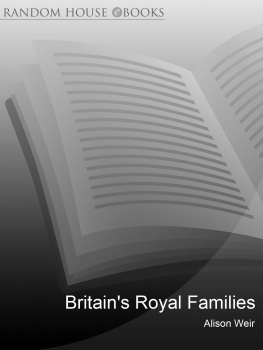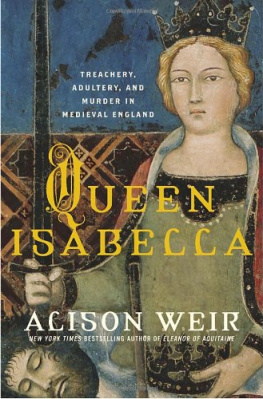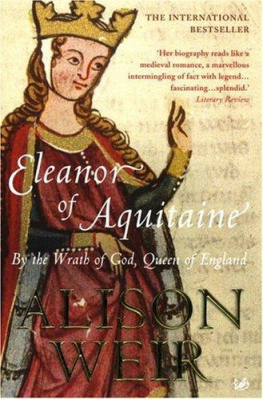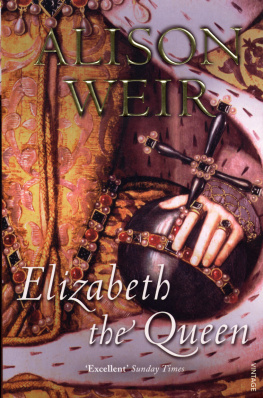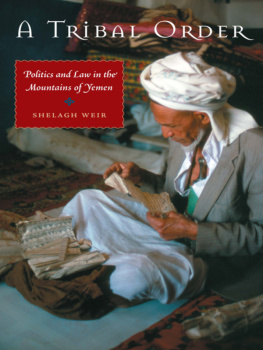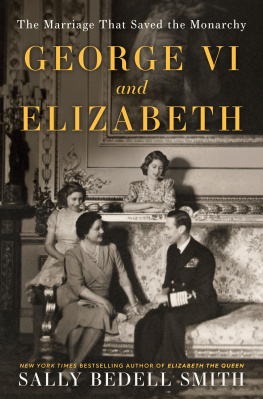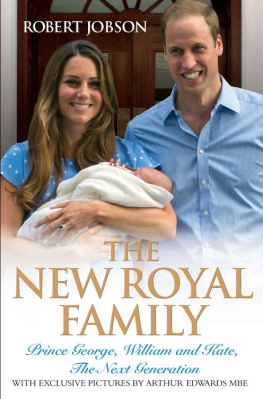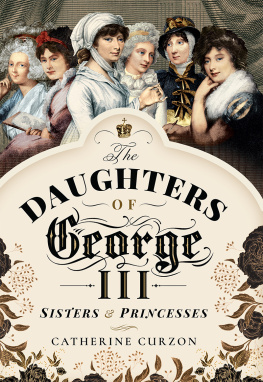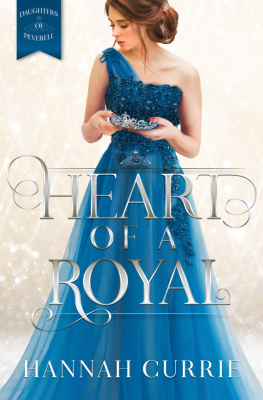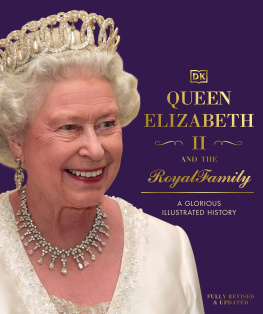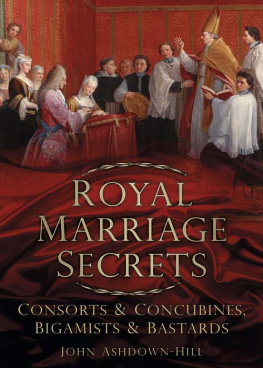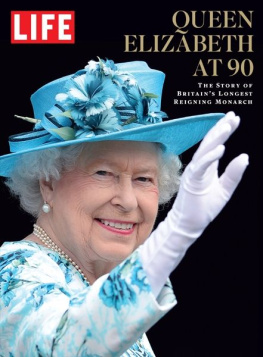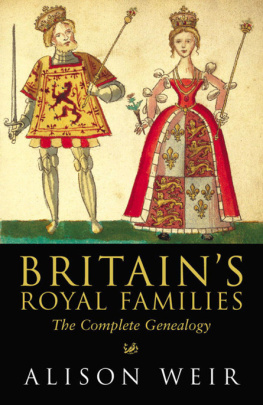About the Author
Alison Weir was born in London and now resides in Surrey. Before becoming a published author in 1989, she was a civil servant, then a housewife and mother. From 1991 to 1997, whilst researching and writing books, she ran a school for children with learning difficulties before taking up writing full-time. Her non-fiction books include The Six Wives of Henry VIII, Lancaster and York, Children of England, Elizabeth the Queen, Eleanor of Aquitaine, Mary Queen of Scots, Henry VIII: King and Court, Isabella and, most recently, The Lady in the Tower. She is also the author of three best-selling novels, Innocent Traitor, The Lady Elizabeth and The Captive Queen.
Also by Alison Weir
Non-fiction
Britains Royal Families: The Complete Genealogy
The Six Wives of Henry VIII
The Princes in the Tower
Lancaster and York: The Wars of the Roses
Children of England: The Heirs of King Henry VIII 1547 1558
Elizabeth the Queen
Eleanor of Aquitaine
Henry VIII: King and Court
Mary Queen of Scots and the Murder of Lord Darnley
Isabella: She Wolf of France, Queen of England
Katherine Swynford: The Story of John of Gaunt and His Scandalous Duchess
The Lady in the Tower: The Fall of Anne Boleyn
Fiction
Innocent Traitor
The Lady Elizabeth
The Captive Queen
Authors Note
The reader may find it helpful to note the following points:
. Britains Royal Families covers the period from A.D. 800 to the present day. The monarchs belonging to each royal house appear in chronological order. Every member of the various royal dynasties of England, Scotland and Great Britain is included, even children who died in infancy. Since the succession has usually been invested in the male line, the descendants of female members of the royal families beyond the first generation have not been included, except where relevant to the succession. Likewise, the descendants of the illegitimate children of monarchs have not been included.
. All names in the book have been Anglicised or Latinised for the sake of clarity. Where a person is known by more than one name, all the alternatives are given.
. Where any fact or date is in dispute, this is indicated in the text, and all the possibilities are listed.
. Many dates are either not known or disputed, and the following examples serve to illustrate how they appear in the text:
Example 1c.848 means around the year or date specified.
Example 2 848/9 means during the period or years specified.
Example 3 848? means the date has been estimated using circumstantial evidence and guesswork, and is purely conjectural.
. The following rule applies to the listing of subjects by name:
Example 1 Name followed by a question mark (?) means there is doubt that the person actually existed.
Example 2 Name preceded by a question mark (?) means there is doubt that the name is correct.
. County boundaries given are those relevant to the period in question.
Select Bibliography
The works consulted during the 22 years it has taken me to research this book are too numerous to mention. What follows is a list of the most important sources. Books marked * are especially recommended for researching royal genealogy. Every effort has been made to trace a publisher for each book listed; unfortunately, this was not possible in every case.
Adam of Usk: Chronicon (ed. E. M. Thompson, 1876).
Adamson, D. & Dewar, P. B.: The House of Nell Gwynn (Kimber, 1974).
Akrigg, G. P. V.: Jacobean Pageant, or the Court of King James I (Hamish Hamilton, 1962).
Albert, M. A.: The Divorce (Harrap, 1965).
Alderman, C. L.: Blood Red the Roses: The Wars of the Roses (Bailey and Swinfen, 1973).
Alexander, Marc: The Outrageous Queens (1977).
H.R.H. Princess Alice, Countess of Athlone: For My Grandchildren (Evans, 1966).
Altschul, M.: A Baronial Family in Mediaeval England: The Clares, 12171314 (Johns Hopkins, 1965).
Ancient Charters, Royal and Private, prior to A.D. 1200 (ed. J. H. Round, Pipe Roll Society, 1888).
Andrews, A: The Royal Whore (Hutchinson, 1971).
The Anglo-Saxon Chronicle (ed. G. N. Garmonsway, Dent, 1954).
Anominalle Chronicle (ed. V. H. Galbraith, 1967).
Appleby, J. T.: England without Richard (Bell, 1965).
Appleby, J. T.: Henry II, the Vanquished King (Bell, 1962).
Appleby, J. T.: The Troubled Reign of King Stephen (Bell, 1969).
Archaeologia (102 vols., Society of Antiquaries of London, 17731969).
Argy, J. & Riches, W.: Britains Royal Brides (Sphere Books, 1977).
Armitage-Smith, S.: John of Gaunt (Constable, 1904).
Ashdown, D. M.: Ladies in Waiting (Arthur Barker, 1976).
Ashdown, D. M.: Princess of Wales (John Murray, 1979).
Ashdown, D. M.: Queen Victorias Mother (Robert Hale, 1974).
Ashley, M.: Charles II, the Man and the Statesman (Weidenfeld and Nicolson, 1971).
Ashley, M.: The Glorious Revolution of 1688 (Hodder and Stoughton, 1966).
Ashley, M.: James II (Dent, 1977).
Ashley, M.: King John (Weidenfeld and Nicolson, 1972).
Ashley, M.: The Stuarts in Love (Hodder and Stoughton, 1963).
Ashley, M.: William I (Weidenfeld and Nicolson, 1973).
Ashton, R.: James I by his Contemporaries (Hutchinson, 1969).
Asser, Bishop: Life of King Alfred (ed. W. M. Stevenson, Oxford University Press, 1904).
Ayling, S.: George the Third (Collins, 1972).
Bacon, Francis: The Life of Henry VII (1622; ed. J. R. Lumby, Cambridge University Press, 1902).
Bagley, J. J.: Henry VIII (Batsford, 1962).
Bagley, J. J.: Margaret of Anjou, Queen of England (Herbert Jenkins, 1948).
Baker, Geoffrey le: Chronicon (ed. E. M. Thompson, Oxford University Press, 1889).
Baker, Richard: A Chronicle of the Kings of England from the Time of the Romans Government unto the Death of King James (1643).
Baker, T.: The Normans (Cassell, 1966).
Barber, R.: Henry Plantagenet: A Biography of Henry II of England (Boydell Press, 1972).
Barlow, F.: Edward the Confessor (Eyre and Spottiswoode, 1970).*
Barlow, F.: The Feudal Kingdom of England (Eyre and Spottiswoode, 1961).
Barlow, F.: William I and the Norman Conquest (Eyre and Spottiswoode, 1965).
Battiscombe, G.: Queen Alexandra (Constable, 1969).
Baxter, S. B.: William III (Longman, 1966).
Bayley, J.: History and Antiquities of the Tower of London (Jennings and Chaplin, 1830).
Beamish, T.: Battle Royal (Muller, 1965).
Beaverbrook, Lord: The Abdication of King Edward VIII (Hamish Hamilton, 1966).
Beckingsale, B. W.: Elizabeth I (Batsford, 1963).
Bennett, D.: King without a Crown (Heinemann, 1977).
Bennett, D.: Vicky (Collins and Harvill, 1971).
Berry, P.: By Royal Appointment (Femina, 1970).
Bevan, B.: Charles the Seconds French Mistress (Robert Hale, 1972).
Bevan, B.:

